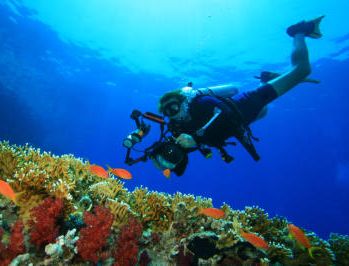Capturing Sealife With Underwater Cameras
 When we look at images of underwater marine life, it may seem like a stunning image but we rarely realize the whole work process that went into it. Unlike others who shoot photographs for a living, underwater photographers face tremendously different challenges and obstacles. Apart from being expert photographers, they also need to be accomplished scuba divers. For their own safety, there are numerous considerations that must be taken. While most these photographers shoot for science or research purposes, others also shoot underwater for fashion editorials, crime scenes, archeology sites, and educational books or magazines. Among the most famous of these hardworking professionals is David Doubilet, who shoots primarily for National Geographic. Since underwater photography is such a specialized, niche field, he had to experiment and invent many techniques in order to achieve impressive results. When we look at images of underwater marine life, it may seem like a stunning image but we rarely realize the whole work process that went into it. Unlike others who shoot photographs for a living, underwater photographers face tremendously different challenges and obstacles. Apart from being expert photographers, they also need to be accomplished scuba divers. For their own safety, there are numerous considerations that must be taken. While most these photographers shoot for science or research purposes, others also shoot underwater for fashion editorials, crime scenes, archeology sites, and educational books or magazines. Among the most famous of these hardworking professionals is David Doubilet, who shoots primarily for National Geographic. Since underwater photography is such a specialized, niche field, he had to experiment and invent many techniques in order to achieve impressive results.
Most underwater photographers actually start out as scuba divers. After achieving an advanced training level, they have the option of training further in specialized fields such as cave diving, wreck dives, search and rescue diving, or underwater photography. For most underwater photographers, their first attempt might be with a simple point and shoot camera designed for underwater use. While the experience is exciting, these basic cameras typically produce rather poor quality images. In order to achieve the sharp, bright, colorful professional images that we see in magazines, the diver has to train and practice a lot. Beyond this, they also need to invest in some rather expensive photography equipment. One of the most important pieces of gear that an underwater photographer needs is a watertight housing. This is usually a plastic and metal casing that fits around the actual camera to protect it from water damage. Housings for DSLR cameras can cost anywhere between a thousand to ten thousand dollars. A phenomenon that scuba divers often notice is that subjects underwater can often look very blue or murky due to the water color. Our brains are able to adjust for this and figure out slightly more accurate colors as we swim around. However, the camera cannot do this. It interprets everything literally, so if we were to simply click the button, the photograph would look overly saturated in blue. In order to reveal the true, vivid colors of marine life, photographers need to use powerful strobes, or flash units. They need to practice carefully to find the best positions for the strobes, so that the lighting looks natural and complimentary.
Another vital consideration for underwater photographers is backup equipment. Imagine shooting seventy-five feet down and suddenly finding that the camera has stopped functioning for some reason or that the batteries have died! Dives are timed very carefully according to the air supply in the tanks, the amount of nitrogen that the diver can safely absorb before it becomes a health risk, and the time required for the ascent. For these reasons, underwater photographers cannot simply shoot up to the surface to get replacement gear. Instead, they (or an assistant) have to carry another set of gear down into the water from the very beginning. Many photographers who simply want vivid, interesting pictures opt for warmer, tropical areas where the local marine life tends to be varied and colorful. Some particularly popular spots include the Great Barrier Reef, and areas around the Philippines, Turkey, and Caribbean. Photographers shooting for research purposes may not have a choice; if they are required to shoot in cold or remote areas, they might find that the marine life there consists of rather murky tones and is well concealed within natural structures. The depth can vary based on where the desired marine life tends to gather. In tropical regions, photographers will find it easier to obtain interesting images at shallow depths, whereas in cold regions, they may have to go quite deep.
Although underwater photography might seem very glamorous, in truth it requires a lot of hard work and meticulous planning. The photographer needs to account for the weather, potential mishaps, location and setting, wind direction, the direction of the sun, and other details. Even after completing the shoot, the image is not yet ready. The photographer has to upload it, make backup copies, and digitally process it to a point where it looks polished and professional.
This article was written by Mike Haldas, co-founder and managing partner of CCTV Camera Pros. If you found it useful, please share it.
|









 When we look at images of underwater marine life, it may seem like a stunning image but we rarely realize the whole work process that went into it. Unlike others who shoot photographs for a living, underwater photographers face tremendously different challenges and obstacles. Apart from being expert photographers, they also need to be accomplished scuba divers. For their own safety, there are numerous considerations that must be taken. While most these photographers shoot for science or research purposes, others also shoot underwater for fashion editorials, crime scenes, archeology sites, and educational books or magazines. Among the most famous of these hardworking professionals is David Doubilet, who shoots primarily for National Geographic. Since underwater photography is such a specialized, niche field, he had to experiment and invent many techniques in order to achieve impressive results.
When we look at images of underwater marine life, it may seem like a stunning image but we rarely realize the whole work process that went into it. Unlike others who shoot photographs for a living, underwater photographers face tremendously different challenges and obstacles. Apart from being expert photographers, they also need to be accomplished scuba divers. For their own safety, there are numerous considerations that must be taken. While most these photographers shoot for science or research purposes, others also shoot underwater for fashion editorials, crime scenes, archeology sites, and educational books or magazines. Among the most famous of these hardworking professionals is David Doubilet, who shoots primarily for National Geographic. Since underwater photography is such a specialized, niche field, he had to experiment and invent many techniques in order to achieve impressive results.

